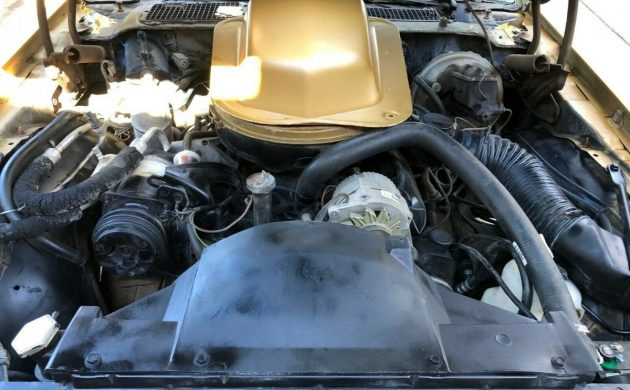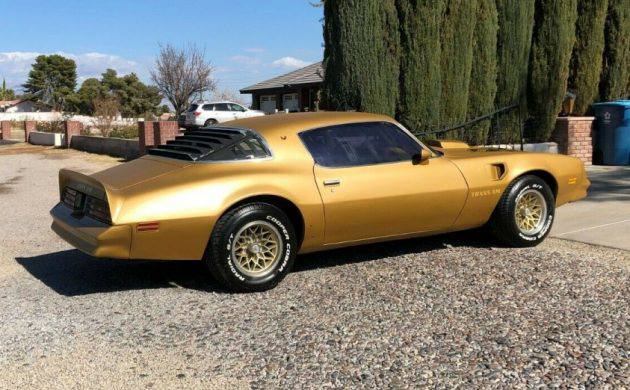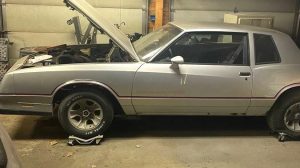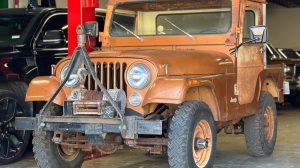It is said that all that glitters is not gold. I’m prepared to argue that claim because this 1978 Pontiac Trans Am not only glitters, but it appears to be a little piece of solid gold. It presents extremely well for an unrestored survivor, and while it isn’t perfect, lifting its presentation to the next level shouldn’t be difficult or expensive. If you think that you might be up for the challenge, you will find the Pontiac located in Las Vegas, Nevada, and listed for sale here on eBay. The bidding has been pretty spirited and has pushed the price along to $10,600. While that is short of the reserve, someone might choose to bypass the auction experience by hitting the BIN button at $13,750.
Pontiac offered some attractive colors in the 1978 Trans Am range, and one of the more distinctive was Solar Gold. That is what graces this car’s panels, and it looks pretty good. The paint holds an impressive shine, with no evidence of the type of deterioration that can occur in locations with harsh UV rays. It is that climate that has also been this classic’s best friend. I think that we’ve all seen Trans Ams of this era that have been consumed by rust, but this one is remarkably clean. There is nothing visible externally, and while the single photo of the car’s underside is hardly definitive, both it and the trunk pan appear to be sound. The only other place that might require a check is the area around the rear valance and the ends of the frame rails. If those are clean, then this Pontiac could be a winner. The vehicle features all of its original decals, including the iconic Screaming Chicken. Once again, these have survived well, as have the rear window louvers. The Trans Am rolls on its original Snowflake alloy wheels, and I can’t spot any problems with those.
Trans Am buyers in 1978 had several engine choices, and this one comes equipped with the 403ci Oldsmobile V8. This motor should be producing 185hp, which finds its way to the rear wheels via a 3-speed automatic transmission. By 1978, tightening emission laws had taken a nasty big bite out of V8 performance figures, meaning that for this Pontiac, the journey down the ¼ mile would take a reasonably leisurely 17.1 seconds. While that might not be anything to write home about, this car had the potential to hit 128mph if you gave it enough space. Potential buyers shouldn’t need to spend a dime on this car’s drivetrain because it seems to be in good health. The owner has recently replaced the alternator, the brakes, the front suspension, and all suspension bushings. He says that the 403 kicks into life without a problem and that it feels strong. Throw a transmission that shifts cleanly into the equation, and the open road will be beckoning this Trans Am and its new owner.
If this Trans Am has a weak point, it is probably the interior. There is nothing catastrophically wrong with it, but it could definitely present better. The majority of its issues have nothing to do with neglect or abuse and have everything to do with what our big yellow friend in the sky has thrown at it. UV rays can be murder on these interiors, and this car isn’t immune. The dash pad is cracked, and the lid on the console has deteriorated badly. Some of the plastic trim in the rear seat shows its age, and the wheel rim is also pretty bad. These issues are related to sun exposure, but the marks on the seats are a result of age and use. There are a couple of ways that a buyer could jump here. Before I spent any money, I would clean everything thoroughly. The seats might spring a pleasant surprise if the right cleaning products are used and could see them given a new lease on life. The wheel and the console lid are a different matter, and the buyer will probably choose to replace both items. The dash pad is potentially the problem child. The owner doesn’t provide a clear picture, so it is hard to determine how bad it is. If it needs to be replaced, that is going to hurt the wallet a lot. A new pad will leave no change from $800, and that’s where the next owner might have to investigate alternatives. If they are willing to bide their time, they might chance upon someone parting out a Trans Am with a good interior. Alternatively, the pad might be a prime candidate for a restoration utilizing a product like Polyvance. A bit of patience can provide some surprising results, so it could be worth consideration. As for the remaining plastic pieces, all is not lost. There are a couple of products available that can be sprayed onto plastic after it has been thoroughly cleaned. This can consolidate the surface and prevent further deterioration. If the buyer then applies a plastic dye in the correct shade, the trim can be returned to a factory appearance for a fraction of the price of new parts. I’ve gone on at great length here, but there is a reason for this. Many people will have looked at this interior and begun investigating the cost of a trim kit. I am simply offering alternatives for potential buyers to consider that could potentially achieve similar results but could save thousands on a restoration.
Some things are impossible to explain, and for me, it is quite why I love the 1978 Pontiac Trans Am. I have always been a blue-blooded Ford man, but a ’78 Trans Am is a GM product that I would park in my garage any day. There is something about the styling and the aura that lifts them a rung above the Camaro and several rungs above the Mustang II. This one looks like a beauty, and its lack of rust is a significant positive attribute for anyone considering handing over their cash for a classic car. It isn’t perfect, but I believe that most of its minor issues could be tackled in a home workshop as time and circumstances permit. When compared to its peers from this era, the ’78 Trans Am stands out for another reason. Most of those cars have experienced dramatic rises and falls in values over recent times, but the Trans Am has remained a constant. It means that it is unlikely to make its owner a lot of money in the future as an investment. However, its history doesn’t suggest that values will drop into the toilet any time soon. If you are looking for a classic car, and what you want is a tidy survivor that you can drive and enjoy, this one deserves a closer look.














Solid Gold Saturday Night!!!
I once owned a 1978 Solar Gold T/A show car. I named it “Solid Gold”. I kick my A#$% for selling it. Now I got a 1979 Black T/A Pontiac 400 W/ T-Tops, WS6. A Smokey & The Bandit Tribute Car if you will.
I am always amazed at how people manage to maintain original decals on a repaint. Neat trick.
That is a real hack way to repaint a car
I did not think they started putting the 403 “Oldsmobugger” motor in T/A’s until 1979? I owned a 1978 Solar Gold T/A with a real Pontiac 400.
The Olds 403 was avail as early as for ’77 t/a’s in California & in high altitude areas.
There was one of these by my house about 10 years ago completely engulfed in sticker bushes. A sign on the front door said “car not for sale.”
How can it be an original hood decal if it’s facing the wrong way?
Hood bird began facing the left in 1978
Also, the sail panel emblems are mounted way too high.
Exactly.
My comment above was sarcastic, calling out how Barnfinds so enthusiastically proclaimed “The vehicle features all of its original decals, including the iconic Screaming Chicken.”
.
You are so right the sail panel birds, although correct, are mounted way too high! I have owned 7 of these cars from 1973 to 1979, an expert I am not but I know a botch job when I see one.
If you look at
http://tran-zam.com/history/SpottingbyYear/HoodBirds.html ,
gold SE’s got the newer not as kewl(IMO) opposite facing hood bird. I believe this car has the wrong hood bird & i have never seen a gold SE with the older style hood bird, but the owner(& myself) actually prefer it.
Regular t/a’s still got the old style ’73-77 hood bird in ’78, but later in the model year there may have been a switch to the new hood bird decal – OR – restorers later on simply put the newer bird on the hoods to replace the old style & on no bird hoods.
This car is not an SE. No T tops is the first clue. Cosmetically the decals are wrong as discussed and column and steering wheel are wrong color. Build sheet or PHS docs will tell rest of story. Tag will say Y88 for OH built cars but not CA so further investigating would be needed if its Van Nuys.
Johnny R,
“In 1979 T-Tops were standard on the Black Special Edition Trans Am but they could be removed using a T-Top delete option that kicked in a $655 credit.”
& you could get a ’77 SE without t-tops …
http://tran-zam.com/articles/img/CDB77-F-9.jpg
Not sure about black ’78s tho, let alone gold ones.
Also, a handful of SE’s did not even come with aluminum snowflake wheels!
All from …
http://tran-zam.com/articles/RallyBandit.aspx